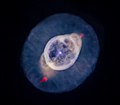ファイル:Caldwell 59.jpg
Caldwell_59.jpg (636 × 554 ピクセル、ファイルサイズ: 142キロバイト、MIME タイプ: image/jpeg)
ウィキメディア・コモンズのファイルページにある説明を、以下に表示します。
|
概要
| 解説Caldwell 59.jpg |
English: After an average star like the Sun finishes burning through the supply of hydrogen and helium fuel in its core, it swells up into a cool, red giant star. In a last gasp before death, it throws off the layers of gas in its outer atmosphere in a brief but beautiful cosmic display called a planetary nebula. This exposes the core of the dying star — a dense, hot ball of carbon and oxygen called a white dwarf, which is doomed to fade out completely over time. The white dwarf is so hot that it shines very brightly in ultraviolet light, which then causes the gaseous material expelled by the dying star to glow.
Hubble’s Wide Field and Planetary Camera 2 captured this image of Caldwell 59, a planetary nebula also cataloged as NGC 3242. The ghostly image is part of a collection of Hubble observations made of planetary nebulas in the mid-1990s, which revealed never-before-seen details in these stellar shrouds and helped astronomers better understand the late evolutionary stages of average, mid-size stars. Caldwell 59 is sometimes called the Ghost of Jupiter for its faint resemblance to our solar system’s ruling gas giant planet, though it is much larger and farther away. If we could travel at the speed of light, we could reach Jupiter in about 40 minutes, but traveling at the same speed to this nebula would take over 1,400 years. Although the star that produced it lived for billions of years, Caldwell 59 only has a lifetime of about 10,000 years. As the white dwarf quickly cools and the ultraviolet light dwindles, the surrounding gas will cool and fade. The gas expelled from the dying star carries traces of newly minted carbon and nitrogen from the atmosphere of the dying star. This material will drift outward through space until it is recycled and drawn in to the formation of a new star. Caldwell 59 was discovered by astronomer William Herschel in 1785. It is found in the Hydra constellation, and from the Northern Hemisphere it is best viewed during spring, although it remains low in the southern sky. It rises much higher in the sky during autumn from the Southern Hemisphere. This magnitude-7.8 cosmic sculpture appears similar in size to the planet Jupiter when seen in the night sky (another reason for its nickname), though through a large telescope it will look startlingly like an eye. For more information about Hubble’s observations of Caldwell 59, see: www.spacetelescope.org/images/opo9738c3/ www.spacetelescope.org/projects/fits_liberator/fitsimages... Credit: NASA, ESA, Bruce Balick and Jason Alexander (University of Washington), Arsen Hajian (U.S. Naval Observatory), Yervant Terzian (Cornell University), Mario Perinotto (University of Florence), Patrizio Patriarchi (Arcetri Observatory) and Reginald Dufour (Rice University); Processing by Gladys Kober (NASA/Catholic University of America) For Hubble's Caldwell catalog site and information on how to find these objects in the night sky, visit: www.nasa.gov/content/goddard/hubble-s-caldwell-catalog |
| 日付 | |
| 原典 | https://www.flickr.com/photos/144614754@N02/49210836978/ |
| 作者 | NASA Hubble |
ライセンス
- あなたは以下の条件に従う場合に限り、自由に
- 共有 – 本作品を複製、頒布、展示、実演できます。
- 再構成 – 二次的著作物を作成できます。
- あなたの従うべき条件は以下の通りです。
- 表示 – あなたは適切なクレジットを表示し、ライセンスへのリンクを提供し、変更があったらその旨を示さなければなりません。これらは合理的であればどのような方法で行っても構いませんが、許諾者があなたやあなたの利用行為を支持していると示唆するような方法は除きます。
| この画像は当初、NASA Hubble によって Flickr の https://flickr.com/photos/144614754@N02/49210836978 に投稿されたものです。2020-02-23、FlickreviewR 2 ボットによってレビューされ、cc-by-2.0 のライセンスで提供されていることが確認されました。 |
2020年2月23日
キャプション
ウィキデータ項目がない値
20 11 2019
image/jpeg
d5fe664fa9892c2e00fdb5f78c43398c58b4c057
145,714 バイト
554 ピクセル
636 ピクセル
ファイルの履歴
過去の版のファイルを表示するには、その版の日時をクリックしてください。
| 日付と時刻 | サムネイル | 寸法 | 利用者 | コメント | |
|---|---|---|---|---|---|
| 現在の版 | 2020年2月23日 (日) 20:03 |  | 636 × 554 (142キロバイト) | Killarnee | User created page with UploadWizard |
ファイルの使用状況
以下のページがこのファイルを使用しています:
メタデータ
このファイルには、追加情報があります (おそらく、作成やデジタル化する際に使用したデジタルカメラやスキャナーが追加したものです)。
このファイルが元の状態から変更されている場合、修正されたファイルを完全に反映していない項目がある場合があります。
| 画像方向 | 通常 |
|---|---|
| 水平方向の解像度 | 72dpi |
| 垂直方向の解像度 | 72dpi |
| 使用ソフトウェア名 | Adobe Photoshop CC 2018 (Macintosh) |
| ファイル変更日時 | 2019年11月27日 (水) 15:05 |
| YCCの画素構成 (YとCの位置) | 中心 |
| Exifバージョン | 2.31 |
| デジタルデータの作成日時 | 2019年11月20日 (水) 12:37 |
| 各コンポーネントの意味 |
|
| 対応フラッシュピックスバージョン | 1 |
| 色空間情報 | sRGB |
| 画像のビットの深さ |
|
| 圧縮の種類 | 無圧縮 |
| 画像の高さ | 554 ピクセル |
| 画像の幅 | 636 ピクセル |
| 画素構成 | RGB |
| コンポーネント数 | 3 |
| メタデータの最終更新日 | 2019年11月27日 (水) 10:05 |
| 元文書の一意なID | xmp.did:1675ad7f-438c-4468-ad86-9a3cfee7bd98 |

